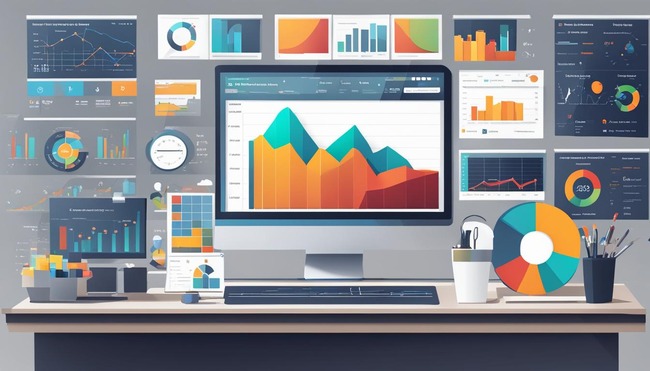As a business owner or supervisor in the Philippines, measuring employee productivity is crucial for achieving business growth and success. Keeping track of employee productivity levels allows you to identify areas for improvement, optimize workflow processes, and enhance employee engagement and motivation. In this section, we will explore various ways to measure employee productivity that can be applied to a variety of industries and businesses.
Productivity measurement is essential to identify the performance of your employees and how they are contributing to your organization’s growth. Evaluating their work helps you to understand their strengths and weaknesses, allowing you to create effective strategies and goals for improving efficiency and effectiveness. By measuring employee productivity, you can take actions to optimize resources, reduce costs, and improve your bottom line.
Key Takeaways:
- Measuring employee productivity is crucial for achieving business growth and success.
- Productivity measurement helps in identifying areas for improvement, optimizing workflow processes, and enhancing employee engagement and motivation.
- Understanding the strengths and weaknesses of your employees helps create effective strategies and goals for improving efficiency and effectiveness.
- Measuring employee productivity can help optimize resources, reduce costs, and improve your bottom line.
- By applying effective strategies and techniques, you can measure employee productivity and ensure your organization maintains high-performance levels.
The Importance of Measuring Employee Productivity
Productivity is important for any business, and evaluating productivity is crucial to business growth. This allows you to determine how efficiently your employees work, identify areas for improvement, and develop strategies to optimize performance. It is an essential tool for business owners and supervisors to evaluate the overall performance of their workforce.
Measuring productivity provides a multitude of benefits for your organization. By implementing effective measurement strategies, you can:
- Identify areas for improvement: By tracking productivity metrics, you can determine which processes require optimization and identify areas where employees may need additional training.
- Manage resources more effectively: Measuring productivity allows you to allocate resources more effectively, ensuring your employees are working on the most important tasks.
- Set achievable goals: With productivity data, you can set realistic goals for your organization and employees, ensuring they are working towards measurable objectives.
Measuring productivity can also help you evaluate the overall performance of your employees. It allows you to determine which employees are performing well and which may require additional support to reach their maximum potential, enabling you to create a fair and equitable work environment.
Overall, measuring employee productivity is an essential practice for any business owner or supervisor. Through effective strategies and measurement techniques, you can evaluate productivity, identify areas for improvement, and optimize performance, driving business growth and success.
Key Metrics for Measuring Employee Productivity
Productivity is a crucial element in measuring the success of any business. In order to effectively evaluate productivity, it’s essential to identify and track key metrics that are relevant to your industry and business needs.
Tracking the right productivity metrics can help you identify areas where your team is excelling and areas where they may need additional support. Here are some of the best ways to measure employee productivity:
| Productivity Metrics | Description |
|---|---|
| Output per hour/day/week | This metric measures the amount of output that an employee produces within a given timeframe. It can help you understand an employee’s level of efficiency and identify areas where improvements can be made. |
| Quality of work | Maintaining a high level of quality is essential for any business. Measuring the quality of work produced by an employee can help you identify which team members are meeting expectations and which ones need additional training or support. |
| Attendance and punctuality | Attendance and punctuality are important indicators of an employee’s commitment and reliability. Tracking these metrics can help identify any attendance or time management issues before they become a larger problem. |
| Goal achievement | Setting goals for employees can help motivate them to meet and exceed expectations. Measuring goal achievement can help you identify which employees are excelling, and which ones need additional support or guidance. |
These are just a few examples of productivity metrics that you can track. The most important thing is to identify the metrics that are most relevant to your business needs and industry.

Use these productivity metrics to gauge the productivity levels of your workforce and find ways to improve them.
Strategies to Improve Employee Productivity
Improving employee productivity is key to achieving business goals and driving growth. Consider these effective strategies to boost employee productivity:
- Set Clear Goals: Ensure your employees understand their specific goals and how they fit into the bigger picture. Clear objectives can motivate and provide direction, leading to a more focused and productive workforce.
- Provide Regular Feedback: Offering constructive feedback on employee performance can help identify areas for improvement and encourage them to work smarter. Positive feedback on achievements can also increase morale and boost productivity.
- Encourage Time Management: Efficient time management is essential for improving productivity. Encourage your employees to prioritize, delegate tasks, and limit distractions to ensure they make the most of their workday.
- Invest in Training and Development: Offering your employees training and development opportunities can not only enhance their skills but also make them feel valued and motivated. Upskilling can lead to a more efficient and effective workforce, increasing overall productivity.
- Promote Work-Life Balance: Burnout can negatively impact employee productivity. Encourage your employees to take breaks and disconnect after work hours. A healthy work-life balance can lead to increased job satisfaction and a more engaged and productive workforce.
Employee Engagement
Engaged employees are more productive and typically demonstrate higher levels of commitment and job satisfaction. Consider these employee engagement strategies:
- Recognize and Reward: A simple “thank you” or recognition for a job well done can go a long way in boosting employee morale and motivation, leading to increased productivity.
- Promote Collaboration: Encourage teamwork, communication, and collaboration within your workforce to foster a positive working environment and improve productivity levels.
- Provide a Safe and Healthy Workplace: A safe and healthy work environment can promote employee satisfaction, reduce absenteeism, and increase overall productivity levels.
Workflow Optimization
Optimizing workflows can lead to a more efficient and effective workforce. Consider employing these techniques:
- Use of Technology: Embrace technology to automate repetitive tasks, increase accuracy and reduce errors. Utilize software such as project management tools, time trackers, and communication software to streamline workflows and enhance productivity.
- Regular Meetings: Schedule regular meetings with your team to discuss progress, identify roadblocks, and brainstorm ideas to improve productivity.
- Continuous Improvement: Regularly review and update workflows to optimize productivity, and encourage employee feedback and suggestions for improvement.
Implementing these strategies to improve employee productivity can lead to significant business growth and success. Utilize these tactics to enhance productivity and drive your organization forward.
Tools and Software for Measuring Productivity
Technology can greatly assist in measuring productivity. By utilizing various productivity tools and software, organizations can streamline the process of tracking and evaluating productivity, making it easier and more efficient to measure productivity levels. Below are some of the most popular tools and software for measuring productivity:
1. Tarkie Work From Home (WFH) Tool
Tarkie WFH tool provides a straightforward way to monitor employee productivity, including keyboard and mouse activity, along with occasional screen captures taken randomly. It’s essential to clarify that this monitoring isn’t about distrust but rather about assisting employees in managing their productivity effectively. This feature ensures that employees stay on track with their tasks and provides valuable insights into work habits, enabling better time management and productivity optimization.
2. Hubstaff
Hubstaff is time-tracking software that enables managers to monitor employee productivity and time spent on tasks. With Hubstaff, you can track employee hours, activity levels, and overall productivity. The software also offers features like automated payroll and project budgeting to help simplify business operations.
3. Google Workspace
Google Workspace (formerly G Suite) offers several productivity tools that businesses can use to measure and enhance employee productivity. Apps like Gmail, Google Drive, and Google Meet can help teams collaborate and communicate more efficiently. Google Workspace also comes with features like real-time collaboration and document sharing to improve workflow and productivity.
By using these productivity tools and software, businesses can effectively measure employee productivity and take appropriate actions to improve them.

Effective Methods for Measuring Remote Employee Productivity
With the rise of remote work, it is essential to measure workplace productivity for remote employees. While managing remote employees can be a challenging task, measuring their productivity can be a bit easier when done right. Here are some effective methods to measure remote employee productivity:
- Set clear productivity goals: Create clear and specific goals for your employees working from home to focus on. By setting clear targets, it will be easier to measure their productivity.
- Use time-tracking software: Time-tracking software can be an effective tool to measure the amount of time your employees are spending on productive tasks.
- Regular check-ins: Schedule regular check-ins with your employees to discuss their progress, and any challenges they may be facing, and to support them in achieving their targets.
- Encourage open communication: Foster an environment of open communication where your employees feel comfortable discussing their progress, ideas, and concerns. This can help establish trust and promote productivity.
Remember, to measure employee productivity effectively, it’s important to set realistic targets and use the right tools. With the right approach, you can ensure that your remote employees stay motivated, productive, and engaged.
Conclusion
Measuring employee productivity is crucial for business growth and development. By implementing effective strategies, tracking key metrics, and utilizing productivity tools, you can enhance productivity levels and drive business growth. It is essential for business owners and supervisors to gauge the performance and efficiency of their workforce.
Remember, enhancing productivity is a continuous process that requires effective strategies. This includes optimizing workflows, setting achievable goals, providing feedback and recognition, and ensuring employee engagement and motivation.
Start Measuring Employee Productivity Today
By measuring employee productivity, you can evaluate the overall performance of your employees and make informed decisions about how to improve it. Use the strategies and tools discussed in this article to start measuring employee productivity today, and reap the benefits it brings to your organization.
Thank you for Reading!
We hope this article has provided you with valuable insights and practical tips on measuring employee productivity. Remember to keep a data-driven approach to measuring productivity, and always seek ways to improve it. Let us know your thoughts and ideas in the comments below.
